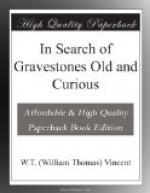Fig. 64.—At Lee.
“To Eliza Drayton, died 11th May, 1770.”
In this allegory Time appears to be commanding Death to extinguish the lamp of Life. The sun may mean the brighter life beyond. The building to the right is an enigma.
Often the first six or seven miles have to be encountered before we reach unexplored ground. The Cray Valley, for instance, may be cited for one day’s experience. First a walk of seven miles to Orpington, one of the five sister churches of the Crays—all said to be Anglo-Saxon and of about one date. I must not digress to speak of churches, but it is only reasonable to suppose that the student who is capable of taking up as a pastime the investigation of churchyards has previously acquired something more or less of archaeological taste, and will not fail to notice the churches.[2] We reach the churchyard of Orpington, visit the church, and then my companion and I separate for our respective duties. I am not fortunate in securing any special prize, but it is well to select some object if only as a souvenir of the visit, and I jot down the following, which may be classed among the commonest order of all figurative headstones, but is nevertheless noticeable as a variant.
[Footnote 2: There are several handbooks of church architecture, and the rudiments of the various orders and dates are easily acquired.]
[Illustration: Fig. 64. Lee.]
[Illustration: Fig. 65. Orpington.]
Fig. 65.—At Orpington, Kent.
“To Hosa Mansfield, daughter of
John and
Martha Mansfield,
died 24th May 1710,
aged 26 years.
Also James Mansfield,
son of John and
Martha Mansfield, died
30th Dec’r
1746, aged 48 years.”
The work in this instance is crude, and apparently done by an inexpert craftsman. The stone is, however, decayed, and it is possible that it is the draughtsman who has blundered. The two skulls, being of different sizes, suggest the male and female occupants of the grave, and would therefore assign the production to the later rather than the earlier date. The two bones are not often found in so




